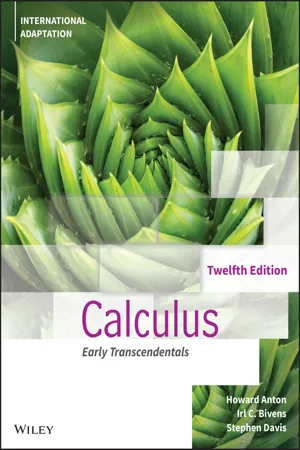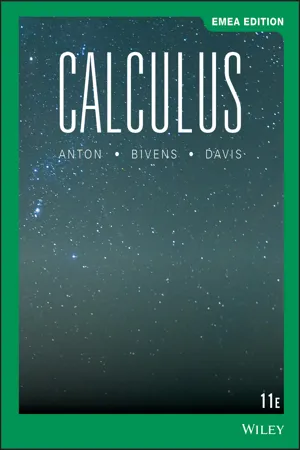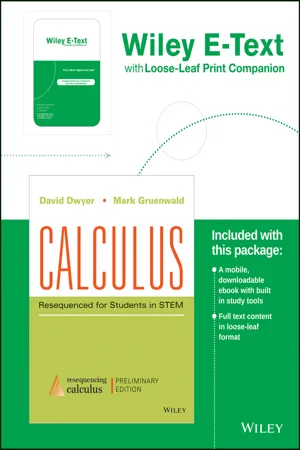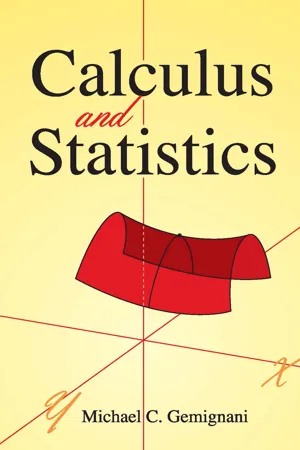Mathematics
Area Between Two Curves
The area between two curves refers to the region enclosed by the graphs of two functions on a given interval. To find this area, one typically computes the definite integral of the absolute difference between the two functions over the specified interval. This concept is commonly used in calculus to solve problems involving finding the area of a region bounded by two curves.
Written by Perlego with AI-assistance
Related key terms
1 of 5
8 Key excerpts on "Area Between Two Curves"
- eBook - PDF
- Howard Anton, Irl C. Bivens, Stephen Davis(Authors)
- 2022(Publication Date)
- Wiley(Publisher)
6.1 Area Between Two Curves 377 ▶ Example 3 Suppose v 1 (t) = t 2 + t + 2 and v 2 (t) = t 2 + 8 are velocity versus time curves for two race cars that move along a straight track, starting from rest at the same time. Give a physical interpretation of the area A between the curves over the interval 0 ≤ t ≤ 5. Solution From (1), A = ∫ 5 0 [v 2 (t) − v 1 (t)] dt = ∫ 5 0 [6 − t] dt = [ 6t − t 2 2 ] 5 0 = 30 − 25 2 = 35 2 Since v 1 and v 2 are nonnegative functions on [0, 5], it follows from Formula (4) of Section 5.7 that the integral of v 1 over [0, 5] is the distance travelled by car 1 during the time interval 0 ≤ t ≤ 5, and the integral of v 2 over [0, 5] is the distance travelled by car 2 during the same time interval. Since v 1 (t) ≤ v 2 (t) on [0, 5], car 2 travels farther than car 1 does over the time interval 0 ≤ t ≤ 5, and the area A represents the distance by which car 2 is ahead of car 1 at time 5. Some regions may require careful thought to determine the integrand and limits of integration in (1). Here is a systematic procedure that you can follow to set up this formula. It is not necessary to make an extremely accurate sketch in Step 1; the only pur- pose of the sketch is to determine which curve is the upper boundary and which is the lower boundary. Setting up an Integral for the Area Between Two Curves Step 1. Sketch the region and then draw a vertical line segment through the region at an arbitrary point x on the x-axis, connecting the top and bottom boundaries (Figure 6.1.8a). Step 2. The y-coordinate of the top endpoint of the line segment sketched in Step 1 will be f (x), the bottom one g(x), and the length of the line segment will be f (x) − g(x). This is the integrand in (1). Step 3. To determine the limits of integration, imagine moving the line segment left and then right. The leftmost position at which the line segment intersects the region is x = a and the rightmost is x = b (Figures 6.1.8b and 6.1.8c). - eBook - PDF
Calculus
Single Variable
- Howard Anton, Irl C. Bivens, Stephen Davis(Authors)
- 2022(Publication Date)
- Wiley(Publisher)
5.1 Area Between Two Curves 275 5.1.2 Area Formula If f and g are continuous functions on the interval [a, b], and if f (x) ≥ g(x) for all x in [a, b], then the area of the region bounded above by y = f (x), below by y = g(x), on the left by the line x = a, and on the right by the line x = b is A = b a [ f (x) − g(x)] dx (1) Example 1 Find the area of the region that is enclosed by the curves y = x + 6, y = x 2 , x = 0, and x = 2. Solution The graph of f (x) = x + 6 lies above the graph of g(x) = x 2 over the interval [0, 2] (Figure 5.1.4). Thus, from (1), A = 2 0 [(x + 6) − x 2 ] dx = x 2 2 + 6x − x 3 3 2 0 = 34 3 − 0 = 34 3 1 2 2 1 3 4 5 6 7 8 x y y = x + 6 y = x 2 FIGURE 5.1.4 It is possible that the upper and lower boundaries of a region may intersect at one or both endpoints, in which case the sides of the region will be points, rather than vertical line segments (Figure 5.1.5). When that occurs you will have to determine the points of intersection to obtain the limits of integration. What does the integral in (1) represent if the graphs of f and g cross each other over the interval [a, b]? How would you find the area between the curves in this case? a b x y y = f (x) y = g(x) Both side boundaries reduce to points. x y a b y = f (x) y = g(x) The left-hand boundary reduces to a point. FIGURE 5.1.5 Example 2 Find the area of the region that is enclosed between the curves y = x 2 and y = x + 6. Solution A sketch of the region (Figure 5.1.6) shows that the lower boundary is y = x 2 and the upper boundary is y = x + 6. At the endpoints of the region, the upper and lower boundaries have the same y-coordinates; thus, to find the endpoints we equate y = x 2 and y = x + 6 (2) This yields x 2 = x + 6 or x 2 − x − 6 = 0 or (x + 2)(x − 3) = 0 from which we obtain x = −2 and x = 3 Although the y-coordinates of the endpoints are not essential to our solution, they may be obtained from (2) by substituting x = −2 and x = 3 in either equation. - eBook - PDF
Calculus
Late Transcendentals
- Howard Anton, Irl C. Bivens, Stephen Davis(Authors)
- 2021(Publication Date)
- Wiley(Publisher)
Here is a systematic procedure that you can follow to set up this formula. It is not necessary to make an extremely accurate sketch in Step 1; the only pur- pose of the sketch is to determine which curve is the upper boundary and which is the lower boundary. Finding the Limits of Integration for the Area Between Two Curves Step 1. Sketch the region and then draw a vertical line segment through the region at an arbitrary point x on the x-axis, connecting the top and bottom boundaries (Figure 5.1.9a). Step 2. The y-coordinate of the top endpoint of the line segment sketched in Step 1 will be f (x), the bottom one g(x), and the length of the line segment will be f (x) − g(x). This is the integrand in (1). Step 3. To determine the limits of integration, imagine moving the line segment left and then right. The leftmost position at which the line segment intersects the region is x = a and the rightmost is x = b (Figures 5.1.9b and 5.1.9c). Figure 5.1.9 5.1 Area Between Two Curves 281 There is a useful way of thinking about this procedure: If you view the vertical line segment as the “cross section” of the region at the point x, then Formula (1) states that the area between the curves is obtained by integrating the length of the cross section over the interval [a, b]. It is possible for the upper or lower boundary of a region to consist of two or more different curves, in which case it will be convenient to subdivide the region into smaller pieces in order to apply Formula (1). This is illustrated in the next example. Example 4 Find the area of the region enclosed by x = y 2 and y = x − 2. Solution. To determine the appropriate boundaries of the region, we need to know where the curves x = y 2 and y = x − 2 intersect. In Example 2 we found intersections by equating the expressions for y. - eBook - PDF
Calculus
Early Transcendentals
- Howard Anton, Irl C. Bivens, Stephen Davis(Authors)
- 2016(Publication Date)
- Wiley(Publisher)
Here is a systematic procedure that you can follow to set up this formula. It is not necessary to make an extremely accurate sketch in Step 1; the only pur- pose of the sketch is to determine which curve is the upper boundary and which is the lower boundary. Finding the Limits of Integration for the Area Between Two Curves Step 1. Sketch the region and then draw a vertical line segment through the region at an arbitrary point x on the x-axis, connecting the top and bottom boundaries (Figure 6.1.9a). Step 2. The y-coordinate of the top endpoint of the line segment sketched in Step 1 will be f (x), the bottom one g(x), and the length of the line segment will be f (x) − g(x). This is the integrand in (1). Step 3. To determine the limits of integration, imagine moving the line segment left and then right. The leftmost position at which the line segment intersects the region is x = a and the rightmost is x = b (Figures 6.1.9b and 6.1.9c). Figure 6.1.9 6.1 Area Between Two Curves 345 There is a useful way of thinking about this procedure: If you view the vertical line segment as the “cross section” of the region at the point x, then Formula (1) states that the area between the curves is obtained by integrating the length of the cross section over the interval [a, b]. It is possible for the upper or lower boundary of a region to consist of two or more different curves, in which case it will be convenient to subdivide the region into smaller pieces in order to apply Formula (1). This is illustrated in the next example. Example 4 Find the area of the region enclosed by x = y 2 and y = x − 2. Solution. To determine the appropriate boundaries of the region, we need to know where the curves x = y 2 and y = x − 2 intersect. In Example 2 we found intersections by equating the expressions for y. - Ronald Harshbarger, James J. Reynolds(Authors)
- 2018(Publication Date)
- Cengage Learning EMEA(Publisher)
We can easily extend this technique to finding the Area Between Two Curves over an interval. Suppose that the graphs of both y 5 f (x) and y 5 g(x) lie above the x-axis and that the graph of y 5 f (x) lies above y 5 g(x) throughout the interval from x 5 a to x 5 b; that is, f (x) $ g(x) on [a, b]. (See Figure 13.14.) Then Figures 13.15(a) and 13.15(b) show the areas under y 5 f (x) and y 5 g(x). Figure 13.15(c) shows how the difference of these two areas can be used to find the area of the region between the graphs of y 5 f (x) and y 5 g(x). That is, Area between the curves 5 2 b a f (x) dx 2 2 b a g(x) dx x y a b (a) f (x) dx a b y = f (x) - x y a b (b) g(x) dx a b y = g(x) = x y a b (c) Area A y = f (x) y = g(x) Although Figure 13.15(c) shows the graphs of both y 5 f (x) and y 5 g(x) lying above the x-axis, this difference of their integrals will always give the area between their graphs if both functions are continuous and if f (x) $ g(x) on the interval [a, b]. Using the fact that 2 b a f (x) dx 2 2 b a g(x) dx 5 2 b a [ f (x) 2 g(x)] dx we have the following result for the Area Between Two Curves. Area Between Two Curves x y a b y = f (x) y = g(x) Figure 13.14 Figure 13.15 Equality of income would result if each family received an equal proportion of the total income, so that the bottom 20% would receive 20% of the total income, the bottom 40% would receive 40%, and so on. The Lorenz curve repre- senting this would have the equation y 5 x. The inequality of income distribution is measured by the Gini coefficient of income, which measures how far the Lorenz curve falls below y 5 x. It is defined as Area between y 5 x and y 5 L(x) Area below y 5 x Because the area of the triangle below y 5 x and above the x-axis from x 5 0 to x 5 1 is 1 > 2, the Gini coefficient of income is Area between y 5 x and y 5 L(x) 1 > 2 5 2 # [area between y 5 x and y 5 L(x)] In this section, we will use the definite integral to find the Area Between Two Curves.- eBook - PDF
Calculus
Resequenced for Students in STEM
- David Dwyer, Mark Gruenwald(Authors)
- 2017(Publication Date)
- Wiley(Publisher)
The area of the translated region will be the same, both translated functions will now be positive over [a, b], and the definite integral over [a, b] of the difference in the translated functions will have the same value as R b a [f (x) - g(x)] dx because the translation constants cancel out. For a more formal verification, we can use an approach similar to the one used in Section 5.2 for finding the area under a curve. We begin by dividing [a, b] into n subintervals, each of width Δx = (b - a)/n. Now in the ith subinterval we form a representative rectangle of width Δx and height f (x i ) - g(x i ), where x i is an arbitrary number chosen in the interval. See Figure 7.10. The area of this representative rectangle is ΔA i = [f (x i ) - g(x i )]Δx 7.1. AVERAGE VALUE AND AREA BETWEEN CURVES 403 By adding up the areas of n rectangles formed in this manner, we determine that the area of the region between the graphs of f and g is approximately n X i=1 ΔA i = n X i=1 [f (x i ) - g(x i )]Δx This sum is a Riemann sum, and so, by taking the limit as n → ∞, we see that Area = lim n→∞ n X i=1 [f (x i ) - g(x i )]Δx = Z b a [f (x) - g(x)] dx Area Between Two Curves If f and g are continuous on [a, b] and f (x) ≥ g(x) for a ≤ x ≤ b, then the area of the region between the graphs of f and g from x = a to x = b is A = Z b a [f (x) - g(x)] dx Example 4 Finding the area of a region Find the area of the region bounded by the graphs of y = x 2 - 2 and y = 1 - 2x. Solution The region between the two curves is shown in Figure 7.11. The left and right boundaries are determined by the intersection points of the two curves. We equate the right-hand sides of y = x 2 - 2 and y = 1 - 2x and solve for x. -2 -1 1 2 3 4 5 6 7 -4 -3 -2 -1 1 2 3 4 y = x 2 - 2 y = 1 - 2x -1 -1 1 Figure 7.11 x 2 - 2 = 1 - 2x x 2 + 2x - 3 = 0 (x + 3)(x - 1) = 0 x = -3, x = 1 Over the interval [-3, 1], the graph of y = 1 - 2x lies above that of y = x 2 - 2. - eBook - ePub
- Michael C. Gemignani(Author)
- 2014(Publication Date)
- Dover Publications(Publisher)
Integration7.1 THE DEFINITE INTEGRAL. AREA UNDER A GRAPHIn Section 5.5 we had occasion to find the area between the graph of certain functions and the x-axis over particular intervals. In both instances (Examples 18 and 19 of Chapter 5 ), the areas concerned were standard geometric figures to which well-known area formulas could be applied. The area between the graph of f(x) = x2 and the x-axis over the interval [0, 1], the shaded portion of Fig. 1 , cannot be found, however, through the application of some standard area formula. If we are to find this area, then, we must do some trailblazing. That is, we must define what we mean by the area of a geometric configuration (such as that shown in Fig. 1 ) which does not fall into one of the “nice” categories for which we already have area formulas. This situation is analogous to our earlier problem of taking the sum of infinitely many numbers. Since we had only the sum of finitely many numbers defined to start with, we had to define what should be meant by the sum of infinitely many numbers. In that case, our definition of infinite sum had to be consistent with (that is, not contradict) what we knew about finite sums. Here, our extended definition of area must be such that it does not contradict the area formulas we already know.Fig. 1Fig. 2Let the area presented in Fig. 1 be denoted by A. Then A lies inside a square with side 1 (Fig. 2 ). Since the area of this square is 1, then A ought to be less than 1 if it is to be consistent with the usual area formulas. Moreover, the shaded area also lies inside the triangle with vertices (0, 0), (1, 0), and (1, 1) (Fig. 2 ). Since the area of this triangle is , then A should be less than .We now partition [0, 1] into four equal closed subintervals [0, ], [ , ], [ , ] and [ , 1]. Over each of these subintervals we erect a rectangle of height f(r) = r2 , where r is the right-hand endpoint of the subinterval (Fig. 3 - eBook - ePub
- Alan Jeffrey(Author)
- 2004(Publication Date)
- Chapman and Hall/CRC(Publisher)
The connection between differentiation and integration is basic to the whole of the calculus and is contained in a result we shall prove later known as the fundamental theorem of calculus. Once again, limiting operations will play an essential part in the development of our argument. In fact we will show not only how they enable a satisfactory general theory of integration to be established, but also how they provide a tool, albeit a clumsy one, for the actual numerical integration of functions. However, aside from a number of simple but important examples, the practical details of the evaluation of integrals of specific classes of function will be deferred until Chapter 8. We begin by seeking to determine the shaded area I of Fig. 7.1 which is interior to the region bounded above and below by the curve y=f (x) and the x -axis, respectively, and to the left and right by the lines x = a,x = b. This approach will lead naturally to what is called the definite integral of f (x) over the interval a ≤ x ≤ b, and it illustrates a valuable geometrical interpretation of the process of integration. Although we use the definite integral to give precise meaning to the notion of the area contained within a closed curve, this appeal to geometry is not actually necessary when defining a definite integral. Indeed, we shall also show how a purely analytical definition of a definite integral, quite independent of any geometrical arguments, may be formulated. Let f (x) be a non-negative continuous function defined in the closed interval [ a, b ] and consider, for a moment, the conceptual problem that arises when trying to determine the area I defined by it in Fig. 7.1
Index pages curate the most relevant extracts from our library of academic textbooks. They’ve been created using an in-house natural language model (NLM), each adding context and meaning to key research topics.







